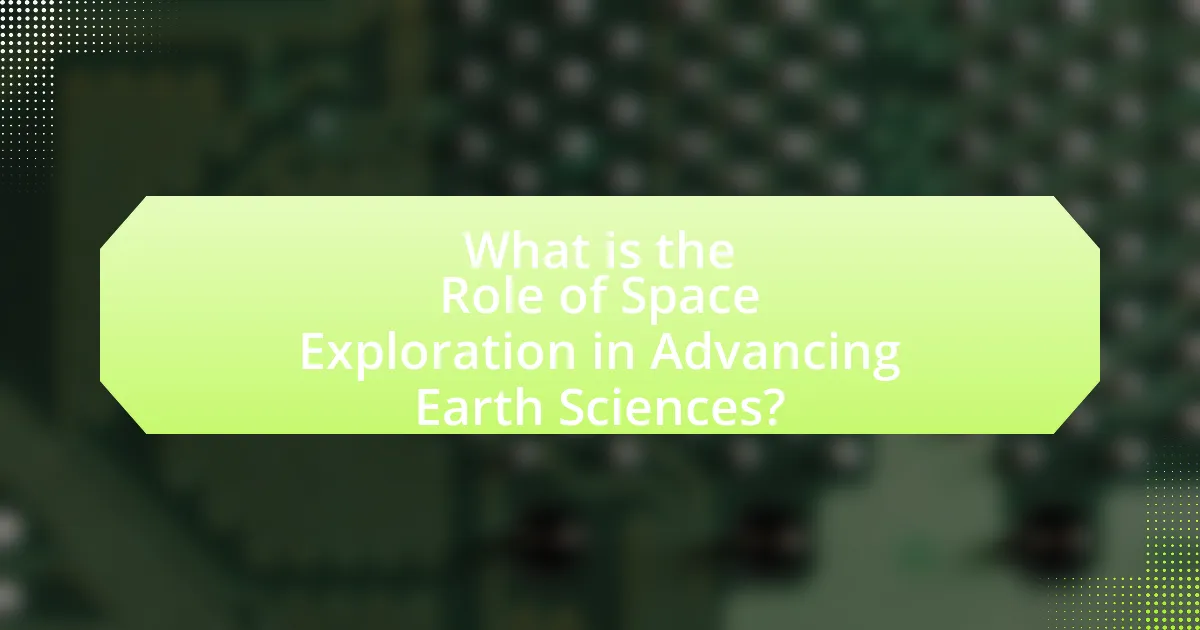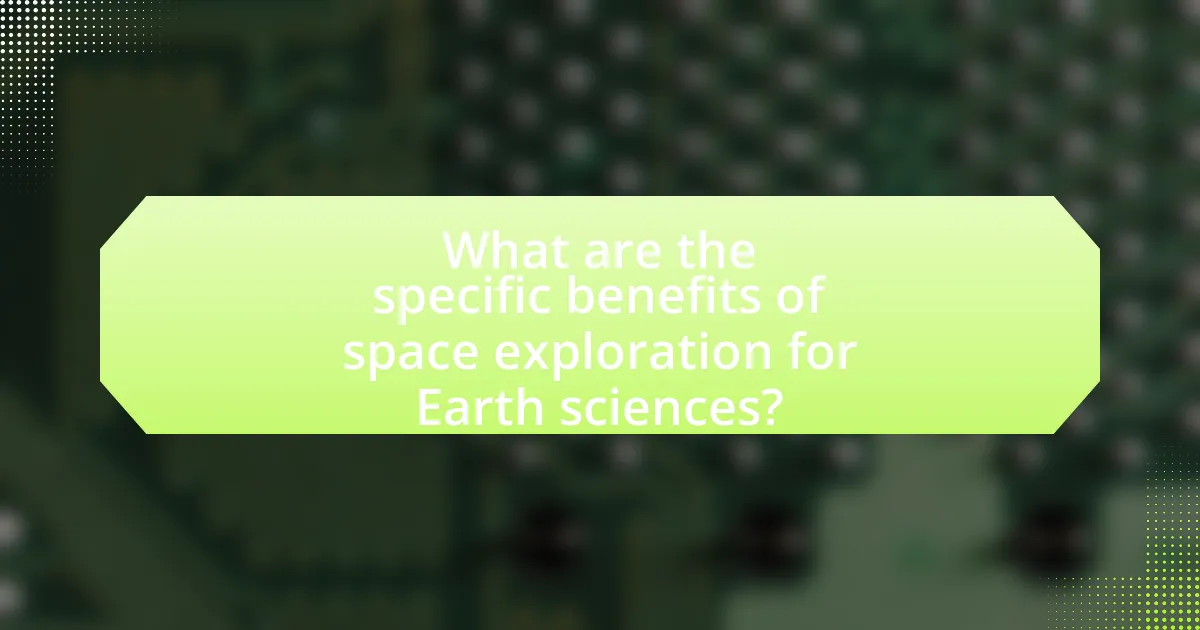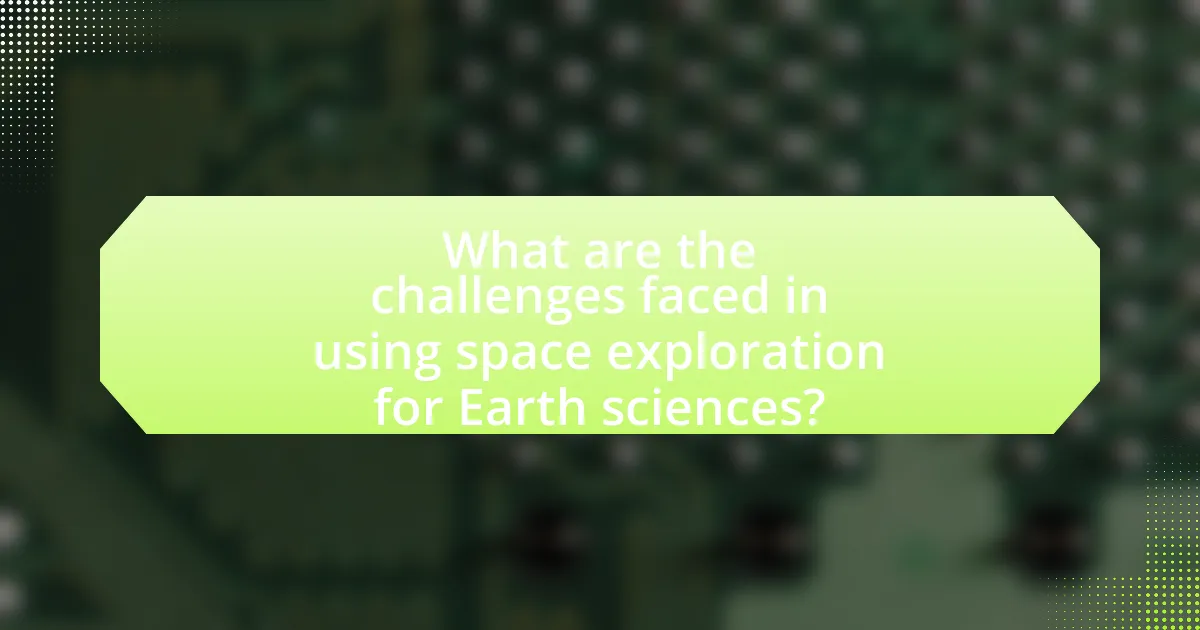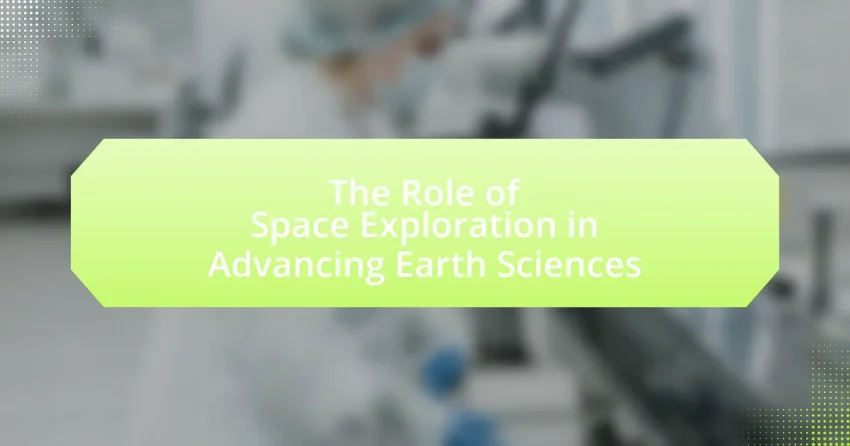The article examines the critical role of space exploration in advancing Earth sciences, highlighting how satellite technology and space missions provide unique data essential for understanding climate change, natural disasters, and Earth’s geological processes. It discusses the contributions of various space programs, such as NASA’s Earth Observing System and the European Space Agency’s Copernicus program, in enhancing climate monitoring and disaster management. Additionally, the article addresses the technologies that improve Earth science research, the benefits of international collaborations, and the challenges faced in utilizing space-based data effectively. Overall, it underscores the importance of space exploration in informing environmental policies and improving predictive models for climate and disaster response.

What is the Role of Space Exploration in Advancing Earth Sciences?
Space exploration plays a crucial role in advancing Earth sciences by providing unique data and insights that are unattainable from the ground. Satellites and space missions enable scientists to monitor Earth’s climate, weather patterns, and natural disasters with unprecedented accuracy. For instance, NASA’s Earth Observing System satellites have collected extensive data on atmospheric composition, land use, and ocean temperatures, which are essential for understanding climate change and its impacts. Additionally, space exploration facilitates the study of Earth’s geology and ecosystems through remote sensing technologies, allowing for comprehensive mapping and analysis of terrestrial and marine environments. This integration of space-based observations with terrestrial data enhances predictive models and informs policy decisions related to environmental management and disaster response.
How does space exploration contribute to our understanding of Earth?
Space exploration enhances our understanding of Earth by providing critical data on its atmosphere, climate, and geological processes. Satellites, such as NASA’s Landsat program, have been instrumental in monitoring land use changes, deforestation, and urbanization, offering insights into human impact on the environment. Additionally, missions like the European Space Agency’s Copernicus program deliver real-time data on air quality and natural disasters, enabling better disaster response and environmental management. These advancements in Earth observation technology have led to improved climate models, which are essential for predicting future climate scenarios and informing policy decisions.
What technologies from space exploration enhance Earth science research?
Technologies from space exploration that enhance Earth science research include satellite remote sensing, GPS technology, and advanced data analytics. Satellite remote sensing allows for the collection of vast amounts of data on Earth’s surface, atmosphere, and oceans, enabling scientists to monitor climate change, natural disasters, and land use changes. For example, NASA’s Landsat program has provided continuous Earth observation data since 1972, facilitating long-term environmental monitoring. GPS technology enhances Earth science research by providing precise location data, which is crucial for studying tectonic movements and natural hazards. Additionally, advanced data analytics, including machine learning algorithms, are employed to process and interpret the large datasets generated by these technologies, leading to more accurate models and predictions in Earth sciences.
How do satellite observations improve climate monitoring?
Satellite observations enhance climate monitoring by providing comprehensive, real-time data on atmospheric conditions, land use, and ocean temperatures. These observations enable scientists to track changes in climate variables over time, such as greenhouse gas concentrations and deforestation rates. For instance, NASA’s MODIS (Moderate Resolution Imaging Spectroradiometer) satellite has been instrumental in monitoring global vegetation cover and land surface temperature, offering critical insights into climate change impacts. Additionally, satellite data improves weather forecasting accuracy and helps in modeling climate scenarios, thereby supporting informed decision-making for climate policy and resource management.
Why is space exploration essential for Earth sciences?
Space exploration is essential for Earth sciences because it provides critical data and insights that enhance our understanding of Earth’s systems. Satellites and space missions collect comprehensive information on climate patterns, atmospheric conditions, and land use changes, which are vital for monitoring environmental changes. For instance, NASA’s Earth Observing System satellites have been instrumental in tracking deforestation, ice melt, and natural disasters, enabling scientists to analyze trends and make informed predictions. This data is crucial for developing models that inform policy decisions and improve disaster preparedness, demonstrating the direct impact of space exploration on Earth sciences.
What are the key scientific questions addressed by space missions?
Space missions address key scientific questions related to the origins and evolution of the solar system, the potential for life beyond Earth, and the understanding of planetary processes. For instance, missions like NASA’s Mars rovers investigate the geological history of Mars to determine if it ever had conditions suitable for life. Additionally, missions such as the Voyager spacecraft have provided insights into the outer planets and their moons, enhancing our understanding of planetary atmospheres and magnetic fields. These missions contribute to our knowledge of Earth’s place in the universe and the fundamental processes that govern planetary systems.
How does space exploration aid in disaster management and response?
Space exploration aids in disaster management and response by providing critical data through satellite technology, which enhances monitoring and assessment of natural disasters. Satellites equipped with remote sensing capabilities can track weather patterns, detect changes in land use, and monitor environmental conditions, enabling timely warnings for events such as hurricanes, floods, and wildfires. For instance, NASA’s Earth Observing System satellites have been instrumental in providing real-time data during disasters, allowing emergency responders to make informed decisions. Additionally, the European Space Agency’s Copernicus program offers high-resolution imagery that supports damage assessment and recovery efforts post-disaster, demonstrating the effectiveness of space-based resources in enhancing disaster preparedness and response strategies.

What are the specific benefits of space exploration for Earth sciences?
Space exploration provides critical benefits for Earth sciences by enhancing our understanding of climate change, natural disasters, and planetary processes. Satellites deployed in space collect vast amounts of data on atmospheric conditions, ocean temperatures, and land use changes, which are essential for climate modeling and predicting weather patterns. For instance, NASA’s Earth Observing System satellites have contributed to tracking deforestation rates and monitoring greenhouse gas emissions, providing concrete data that informs environmental policies. Additionally, space-based observations improve disaster response by offering real-time data during events like hurricanes and wildfires, allowing for more effective management and mitigation strategies. These advancements demonstrate the integral role of space exploration in advancing Earth sciences through precise data collection and analysis.
How do space missions provide data for environmental studies?
Space missions provide data for environmental studies by utilizing remote sensing technologies that collect information about Earth’s atmosphere, land, and oceans. Satellites equipped with sensors measure variables such as temperature, humidity, vegetation cover, and ocean currents, enabling scientists to monitor climate change, deforestation, and natural disasters. For instance, NASA’s MODIS (Moderate Resolution Imaging Spectroradiometer) on the Terra and Aqua satellites captures daily images of Earth’s surface, providing critical data for tracking wildfires, agricultural health, and water quality. This data is essential for developing models that predict environmental changes and inform policy decisions.
What types of data are collected from space that benefit Earth sciences?
Satellite remote sensing collects various types of data from space that significantly benefit Earth sciences. This data includes imagery for land use and land cover mapping, atmospheric measurements for weather forecasting and climate monitoring, oceanographic data for studying sea surface temperatures and currents, and geospatial data for assessing natural disasters and environmental changes. For instance, NASA’s Landsat program has provided over 40 years of data on land cover changes, which is crucial for understanding ecological dynamics and human impacts on the environment. Additionally, the European Space Agency’s Copernicus program offers comprehensive data on air quality and greenhouse gas emissions, aiding in climate research and policy-making.
How is this data utilized in climate change research?
Data from space exploration is utilized in climate change research by providing critical information on Earth’s climate systems, atmospheric composition, and surface changes. Satellites collect data on temperature, greenhouse gas concentrations, and land use changes, which are essential for modeling climate patterns and predicting future climate scenarios. For instance, NASA’s Earth Observing System satellites have documented a 1.2 degrees Celsius increase in global average temperature since the late 19th century, highlighting the urgency of climate action. This data enables scientists to analyze trends, assess the impacts of climate change, and inform policy decisions aimed at mitigation and adaptation strategies.
What role do international collaborations play in space exploration for Earth sciences?
International collaborations are essential in space exploration for Earth sciences as they enhance resource sharing, expertise, and data collection. These partnerships enable countries to pool financial and technological resources, leading to more comprehensive and ambitious missions. For instance, the International Space Station (ISS) serves as a platform for various Earth observation experiments, involving multiple nations like the United States, Russia, and Japan, which collectively contribute to understanding climate change and natural disasters. Additionally, collaborative missions such as the European Space Agency’s Copernicus program provide critical satellite data that supports global environmental monitoring, demonstrating the effectiveness of joint efforts in advancing Earth sciences.
How do partnerships enhance data sharing and research outcomes?
Partnerships enhance data sharing and research outcomes by facilitating collaboration among diverse stakeholders, including academic institutions, government agencies, and private organizations. This collaboration leads to the pooling of resources, expertise, and data, which significantly improves the quality and scope of research. For instance, the collaboration between NASA and the European Space Agency has resulted in shared satellite data that enhances climate monitoring and environmental assessments. Such partnerships enable researchers to access larger datasets, leading to more comprehensive analyses and innovative solutions in Earth sciences.
What are some successful examples of international space missions?
Successful examples of international space missions include the International Space Station (ISS), the Mars Science Laboratory (Curiosity Rover), and the Hubble Space Telescope. The ISS, a collaborative effort involving NASA, Roscosmos, ESA, JAXA, and CSA, has been continuously inhabited since 2000, facilitating numerous scientific experiments that advance our understanding of Earth and space. The Mars Science Laboratory, launched in 2011, successfully landed the Curiosity Rover on Mars, providing critical data about the planet’s geology and climate, which informs our understanding of potential life beyond Earth. The Hubble Space Telescope, a joint project between NASA and ESA, has revolutionized astronomy since its launch in 1990, offering insights into the universe’s formation and the nature of distant celestial bodies. These missions exemplify the collaborative efforts in space exploration that enhance Earth sciences.

What are the challenges faced in using space exploration for Earth sciences?
The challenges faced in using space exploration for Earth sciences include high costs, technological limitations, and data interpretation complexities. High costs are a significant barrier, as launching and maintaining satellites and space missions require substantial financial investment, often exceeding billions of dollars. Technological limitations arise from the need for advanced instruments capable of collecting accurate data in harsh space environments, which can hinder the effectiveness of Earth observation. Additionally, data interpretation complexities stem from the vast amounts of data generated by space missions, necessitating sophisticated analytical tools and expertise to extract meaningful insights, which can be resource-intensive and time-consuming.
What limitations exist in current space-based Earth science technologies?
Current space-based Earth science technologies face limitations such as high costs, data accessibility issues, and resolution constraints. High costs hinder the development and deployment of advanced satellites, making it difficult for many countries to participate in Earth observation initiatives. Data accessibility issues arise from the complexity of data formats and the need for specialized software to analyze the information, which can limit the usability of the data for researchers and policymakers. Additionally, resolution constraints in satellite imagery can restrict the ability to monitor small-scale environmental changes, impacting the effectiveness of studies related to climate change and natural disasters. These limitations highlight the challenges in fully leveraging space-based technologies for comprehensive Earth science research.
How do budget constraints affect space exploration initiatives?
Budget constraints significantly limit the scope and scale of space exploration initiatives. When funding is restricted, space agencies must prioritize missions, often leading to the cancellation or postponement of projects that could advance scientific knowledge. For instance, NASA’s budget cuts in the early 2010s resulted in the delay of the Mars Sample Return mission, which is crucial for understanding planetary geology and potential life on Mars. Additionally, limited budgets can restrict the development of new technologies, reducing the ability to conduct innovative experiments and gather comprehensive data. This ultimately hampers the potential advancements in Earth sciences that could arise from space exploration, as fewer missions mean less data and fewer opportunities for breakthroughs in understanding Earth’s systems.
What are the technical challenges in satellite data interpretation?
The technical challenges in satellite data interpretation include data volume, sensor calibration, atmospheric interference, and data fusion. The vast amount of data generated by satellites can overwhelm processing capabilities, making it difficult to extract meaningful insights. Sensor calibration is crucial, as inaccuracies can lead to erroneous interpretations of the data. Atmospheric interference, such as clouds and aerosols, can obscure the signals being measured, complicating analysis. Additionally, integrating data from multiple sources or sensors, known as data fusion, presents challenges in ensuring compatibility and accuracy. These challenges are well-documented in studies such as “Challenges in Satellite Data Processing” by Smith et al., published in the Journal of Remote Sensing, which highlights the complexities involved in effectively interpreting satellite data for Earth sciences.
How can these challenges be addressed to improve outcomes?
To address the challenges in space exploration that impact Earth sciences, collaboration among international space agencies can enhance resource sharing and knowledge transfer. For instance, the partnership between NASA and ESA has led to significant advancements in climate monitoring through shared satellite data, improving the accuracy of climate models. Additionally, investing in advanced technology, such as AI and machine learning, can optimize data analysis from space missions, as demonstrated by the use of AI in processing satellite imagery for environmental monitoring. These strategies not only mitigate existing challenges but also lead to more effective outcomes in understanding and addressing Earth’s environmental issues.
What innovations are being developed to enhance satellite capabilities?
Innovations being developed to enhance satellite capabilities include advanced propulsion systems, miniaturization of satellite components, and improved data processing technologies. Advanced propulsion systems, such as electric propulsion, allow satellites to maneuver more efficiently and extend their operational lifespans. Miniaturization enables the deployment of smaller, lighter satellites, which can reduce launch costs and increase the number of satellites in orbit. Improved data processing technologies, including artificial intelligence and machine learning, enhance the ability to analyze and interpret data collected from space, leading to more accurate Earth observation and monitoring. These innovations are crucial for advancing Earth sciences by providing more reliable and timely data for climate monitoring, disaster response, and resource management.
How can policy changes support better funding for Earth science missions?
Policy changes can support better funding for Earth science missions by prioritizing climate research and establishing dedicated budgets for Earth observation programs. For instance, the U.S. National Oceanic and Atmospheric Administration (NOAA) has seen increased funding through legislative measures that emphasize the importance of climate data for disaster preparedness and environmental monitoring. Additionally, policies that encourage public-private partnerships can leverage private investment in Earth science technologies, enhancing overall funding. Historical data shows that when governments allocate specific funding streams for Earth science, such as the 2018 U.S. budget increase for NASA’s Earth Science Division, mission capabilities and research outputs significantly improve.
What practical steps can researchers take to leverage space exploration in Earth sciences?
Researchers can leverage space exploration in Earth sciences by utilizing satellite data for climate monitoring and environmental assessments. Satellites provide high-resolution imagery and real-time data on atmospheric conditions, land use changes, and natural disasters, which are crucial for understanding Earth’s systems. For instance, NASA’s Landsat program has been instrumental in tracking deforestation and urbanization, offering valuable insights into land cover changes over decades. Additionally, researchers can collaborate with space agencies to develop new sensors and instruments tailored for Earth observation, enhancing the accuracy and scope of data collected. This collaboration can lead to advancements in predictive modeling for weather patterns and climate change impacts, as evidenced by the successful integration of satellite data into climate models by the Intergovernmental Panel on Climate Change (IPCC).
How can scientists effectively integrate satellite data into their research?
Scientists can effectively integrate satellite data into their research by utilizing advanced data processing techniques and interdisciplinary collaboration. By employing algorithms for data analysis, such as machine learning and remote sensing methods, researchers can extract valuable insights from satellite imagery. For instance, NASA’s Earth Observing System Data and Information System (EOSDIS) provides access to a vast array of satellite data, enabling scientists to monitor environmental changes, track climate patterns, and assess natural disasters. This integration enhances the accuracy of models and predictions, as evidenced by studies that demonstrate improved climate forecasting when satellite data is incorporated.
What best practices should be followed when collaborating on space missions?
Effective collaboration on space missions requires clear communication, defined roles, and shared objectives among all stakeholders. Clear communication ensures that all team members are aligned on mission goals and updates, which is critical for success in complex environments. Defined roles help to establish accountability and streamline decision-making processes, reducing the risk of overlap or confusion. Shared objectives foster a unified vision, enabling teams to work cohesively towards common goals.
Additionally, utilizing standardized protocols and documentation practices enhances collaboration by providing a consistent framework for information sharing and task execution. Historical examples, such as the International Space Station (ISS) collaboration, demonstrate that these best practices lead to successful outcomes, as diverse teams from multiple countries effectively work together to conduct scientific research and technological development.
